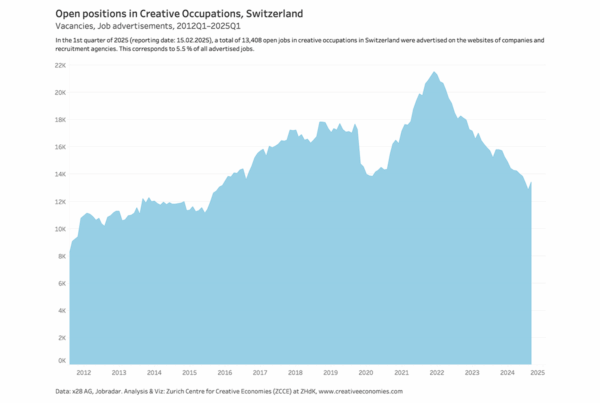The figures show the development of the number of employed persons in creative occupations Switzerland for the years 2010-2022.
Overview
In 2022, a total of 414,000 persons were employed in creative occupations in Switzerland, which is 1.8% (+7,000) more than in 2021 (407,000). In contrast, the number of employed persons in the overall economy increased by 0.6% (+28,000) compared to the previous year.
In the period between 2010 and 2022, the number of employed persons in creative occupations in Switzerland increased by 127,000 (+44%, 2.8% on average). In comparison, the total workforce increased by 505,000 persons employed (+12%, +0.9% on average).

Remark: In 2021, the Swiss Labour Force Survey (SLFS) used here has made a method change in the survey, from a telephone survey to an online questionnaire. For this reason, there is a method break: for part of the results greater caution should be exercised when comparing over time with the years prior to 2021.
IT, software and computer services with strongest growth
Between 2010 and 2022, the number of employed persons in the creative services segment (‘Advertising and marketing’, ‘Architecture’, ‘Design: product, graphic and fashion design’, ‘IT, software and computer services’) increased sharply (+61.8%), while it decreased (-8.3%) in the content production segment (‘Crafts’, ‘Film, TV, video, radio and photography’, ‘Publishing’, ‘Museums, galleries and libraries’, ‘Music, performing and visual arts’) .
The creative occupations groups ‘IT, software and computer services’ (+132%), ‘Advertising and marketing’ (+53%), ‘Music, performing and visual arts’ (+36%), ‘Architecture’ (+34%), ‘Film, TV, video, radio and photography’ (+32%), ‘Museums, galleries and libraries’ (+16%) and ‘Design: Product, graphic and fashion design’ (+3%) increased, while the groups ‘Publishing’ (-11%) and ‘Crafts’ (-49%) decreased.
Methodology
Based on the classification for creative occupations and industries according to UK’s DCMS and Innovation Foundation Nesta,[2] we estimate the employment in creative occupations in Switzerland using the Swiss Labour Force Survey (SLFS).[3]
This approach rests on the assumption that creative occupations also exist outside the creative industries: «This methodology is based on the theoretical and empirical argument that the creative industries are ‘those industries that specialise in the employment of creative talent for commercial purposes’— that is, have unusually high proportions of their workforce employed in creative occupations (‘creative intensity’).»[4]
Further information in our Creative Economies Reports and in the Research Notes.
Notes
[1] See also our complementary analysis on creative industries enterprises with their businesses and employees.
[2] The Dynamic Mapping methodology, originally applied by Nesta to classify the creative economy, consists of three stages. First, a set of occupations is identified as creative. Second, the workforce intensity of these occupations is calculated for each industry. Third, based on the distribution of creative intensity across industries, a threshold intensity is identified, above which all industries are determined to be creative for measurement purposes, while those below the threshold are not. Finally, creative economy employment is estimated according to the Creative Trident approach.
[3] See Frédéric Martel, Christoph Weckerle, Roman Page, Grand Simon: «Sleeping Beauty – four research notes on the effects of the corona crisis». I-IV, ZCCE/ZHdK, 2020.
See Christoph Weckerle, Simon Grand, Frédéric Martel, Roman Page and Fabienne Schmuki, Entrepreneurial Strategies for a Positive Economy, 3rd Creative Economies Report Switzerland, Zürich 2018.
See Christoph Weckerle, Roman Page, Simon Grand: Von der Kreativwirtschaft zu den Creative Economies. Kreativwirtschaftsbericht Schweiz, Zürich 2016.
[4] Bakhshi Hasan, Hargreaves Ian, Mateos-Garcia Juan: A Manifesto for the Creative Economy. Nesta, London 2013.




